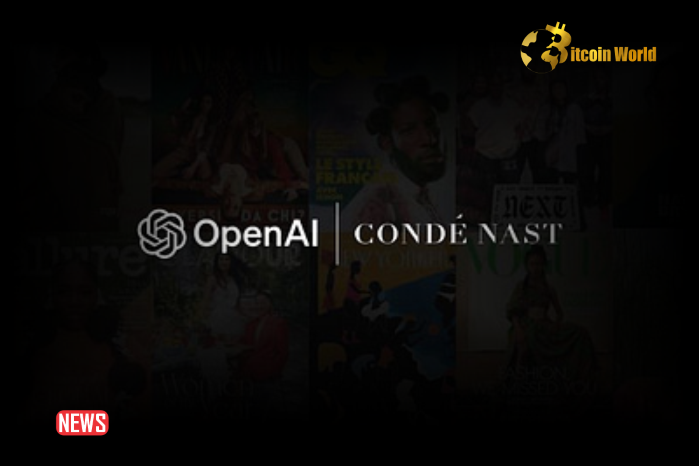In a move signaling a significant shift in the media and artificial intelligence landscape, publishing giant Condé Nast has inked a multi-year partnership with OpenAI, the pioneering force behind ChatGPT. This deal grants OpenAI access to Condé Nast’s vast treasure trove of content, spanning iconic magazines like Wired, The New Yorker, GQ, and Vogue. But what does this partnership really mean for the future of news, content creation, and how we consume information? Let’s dive in.
What’s Cooking? Condé Nast Content Meets OpenAI’s AI Brain
The core of this partnership is straightforward yet impactful. OpenAI’s cutting-edge conversational models, including the prototype SearchGPT and the widely popular ChatGPT, will now be enriched with Condé Nast’s extensive library of articles. Think about it – AI models learning from decades of high-quality journalism, insightful features, and trendsetting articles.
OpenAI announced the collaboration, emphasizing the goal to provide users with “fast and timely answers with clear and relevant sources.” SearchGPT, in particular, will now offer “direct links to news stories,” promising a more transparent and credible information retrieval experience. The ultimate aim is to integrate this enhanced capability into ChatGPT, making it an even more powerful and reliable source of information.
Why is Condé Nast Betting on AI?
For Condé Nast, this partnership isn’t just about keeping up with the times; it’s a strategic move to navigate the evolving digital landscape. In a memo to employees, CEO Roger Lynch highlighted the crucial aspect of adapting to how audiences now discover information. “Generative AI is rapidly changing ways audiences are discovering information,” Lynch stated, underscoring the necessity for Condé Nast to “meet audiences where they are and embrace new technologies.”
But beyond just being present where audiences are, there’s a significant financial incentive. Lynch pointed out the long-standing struggle of news and digital media to effectively monetize content in an era dominated by tech platforms. This partnership with OpenAI presents a potential avenue to recoup lost revenue and, importantly, “continue to protect and invest in our journalism and creative endeavors.” It’s about securing the future of quality content creation in a world increasingly shaped by AI.
OpenAI’s Perspective: Quality Content for Smarter AI
What does OpenAI gain from this alliance? Access to Condé Nast’s premium content is a significant advantage. Training AI models on high-quality, curated content from reputable sources is crucial for improving accuracy, reliability, and the overall user experience. By incorporating Condé Nast’s articles, OpenAI aims to make its AI models:
- More Informed: Drawing from a wider and deeper pool of knowledge.
- More Credible: Linking to trusted sources like The New Yorker and Wired.
- More Nuanced: Learning from sophisticated writing and diverse perspectives.
Brad Lightcap, COO of OpenAI, echoed this sentiment, stating their commitment to working with news publishers to ensure AI maintains “accuracy, integrity, and respect for quality reporting.” This partnership is a step towards building AI that not only provides information but also upholds journalistic standards.
The Publisher’s Dilemma: Embracing AI While Protecting Intellectual Property
Condé Nast isn’t alone in exploring AI partnerships. They join a growing list of publishers, including the Associated Press, Financial Times, News Corp (home to The Wall Street Journal), and Meredith Corporation (publishers of People and Better Homes & Gardens), all forging deals with OpenAI. This trend highlights a crucial industry-wide conversation: how can media companies leverage AI’s potential while ensuring fair compensation and protecting their intellectual property?
Lynch emphasized the importance of “proper attribution and compensation” in the Condé Nast-OpenAI deal. While the specific terms remain undisclosed, this statement signals a growing awareness within the publishing industry of the need for sustainable models in the age of AI. It’s not just about licensing content; it’s about establishing a framework where quality journalism is valued and fairly compensated in the AI ecosystem.
Navigating the AI Frontier: Challenges and Concerns
Despite the enthusiasm surrounding these partnerships, the path forward isn’t without its bumps. OpenAI is currently embroiled in copyright infringement lawsuits with major news publishers, including The New York Times and other Tribune Publishing outlets. These legal battles underscore the complex legal and ethical questions surrounding AI’s use of copyrighted material.
Furthermore, media organizations are also grappling with the internal implications of generative AI. Even the Associated Press, despite its partnership with OpenAI, has issued guidelines limiting how staff journalists can use generative AI, treating AI outputs as “unvetted source material.” This cautious approach reflects concerns about accuracy, bias, and the potential for AI to undermine journalistic integrity if not used responsibly.
Looking Ahead: A New Chapter for AI and Content?
The Condé Nast-OpenAI partnership represents a fascinating experiment at the intersection of AI and high-quality content. It’s a step towards a future where AI can provide more informed, credible, and nuanced information, potentially powered by the depth and breadth of journalistic archives.
Key takeaways from this development:
- AI and Media Collaboration is Growing: More publishers are seeking partnerships with AI companies.
- Revenue and Reach are Key Motivators: Publishers aim to monetize content in the AI age and expand their audience reach.
- Content Quality Matters for AI: OpenAI values high-quality content to improve its models.
- Challenges Remain: Copyright, ethical use of AI in newsrooms, and ensuring journalistic integrity are ongoing concerns.
As AI continues to evolve, partnerships like this will be crucial in shaping its role in news discovery and delivery. The industry is watching closely to see if this collaboration can pave the way for a sustainable and mutually beneficial relationship between AI and quality journalism, ultimately serving the public with more reliable and insightful information.
Disclaimer: The information provided is not trading advice, Bitcoinworld.co.in holds no liability for any investments made based on the information provided on this page. We strongly recommend independent research and/or consultation with a qualified professional before making any investment decisions.


